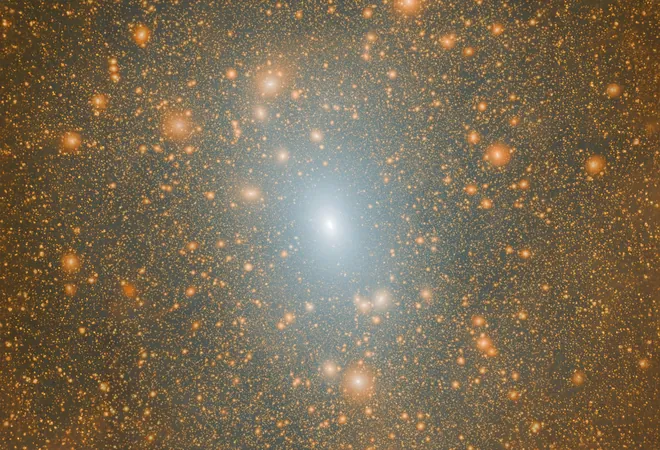
Hidden 'Ghost Galaxies' Could Revolutionize Our Understanding of the Milky Way
2025-07-12
Author: Rajesh
A Surprising Discovery on Our Cosmic Doorstep
Astronomers are on the verge of uncovering a treasure trove of 'ghost galaxies' lurking near the Milky Way. New calculations suggest that as many as 100 ultra-faint satellite galaxies might be orbiting our galaxy unnoticed, potentially reshaping our knowledge of the universe.
The Challenge of Detecting the Faintest Galaxies
These ghostly satellite galaxies are so dim that they have evaded detection in current surveys. However, their presence is crucial for validating existing cosmic theories. A team from Durham University conducted cutting-edge simulations to predict these hidden companions, combining advanced mathematical modeling with powerful supercomputing.
Orphan Galaxies and Dark Matter Mysteries
Many of these satellites are believed to be 'orphan' galaxies, stripped of the dark matter that once enveloped them. This finding could resolve a longstanding inconsistency in our understanding of galaxy formation by aligning theoretical predictions with observable reality.
Understanding the Galactic Framework
The research is based on the Lambda Cold Dark Matter (LCDM) framework, which posits that ordinary matter constitutes just 5% of the universe, with cold dark matter accounting for 25% and dark energy making up a staggering 70%. While current models predict a plethora of dwarf galaxies surrounding the Milky Way, the actual catalog is much smaller, leading to speculation about missing satellites.
High-Resolution Simulations Uncover Hidden Galaxies
By utilizing the Aquarius simulation, a detailed model of a Milky Way-like dark matter halo, researchers were able to 'revive' these lost halos and trace their stellar remnants over 13 billion years. The result is a family of faint galaxies with histories similar to their brighter counterparts.
A New Dawn for Galaxy Hunting
Lead author Isabel Santos-Santos expresses excitement about the potential discovery of these faint galaxies. With the Vera C. Rubin Observatory's LSST camera almost operational, astronomers are poised to bring these ghostly entities into the light.
What Lies Ahead for Observational Astronomy?
As technology advances, astronomers have already identified around 30 ultra-faint galaxy candidates, though their true nature remains debated. This study asserts that many of these may indeed be genuine galaxies, with the promise of more being discovered.
Strengthening the LCDM Theory
If the predicted ghost galaxies are confirmed, it would substantially bolster the LCDM framework for galaxy formation, alleviating doubts associated with the 'missing satellite' and 'too big to fail' issues. The idea that these ghostly satellites might merely be undetected fragments of dark matter could turn a perceived failure of theory into a triumph of detection.
The Quest for Hidden Neighbors Begins
With the LSST's ambitious goal of mapping the southern skies in unprecedented detail, the search for these elusive satellites promises to accelerate. Additional spacecraft, like the European Space Agency's Euclid telescope, will further refine our cosmic vision.
Why it Matters to Us All
Discovering even a fraction of these orphan galaxies would provide a unique laboratory for testing dark matter's innermost behaviors and the survival of stars in extreme conditions. It would also remind us that the seemingly tranquil Milky Way is part of a vibrant and intricate cosmic tapestry.
Though still shadows in our simulations, the prospect of revealing these hidden galaxies is an upcoming frontier that could enhance our understanding of how galaxies form and evolve in the abyss of space.
Stay Tuned for Cosmic Revelations!
The revelations from this research were presented at the National Astronomy Meeting organized by the Royal Astronomical Society. The hunt for these ghostly companions is just beginning, and exciting discoveries may be right around the corner!

 Brasil (PT)
Brasil (PT)
 Canada (EN)
Canada (EN)
 Chile (ES)
Chile (ES)
 Česko (CS)
Česko (CS)
 대한민국 (KO)
대한민국 (KO)
 España (ES)
España (ES)
 France (FR)
France (FR)
 Hong Kong (EN)
Hong Kong (EN)
 Italia (IT)
Italia (IT)
 日本 (JA)
日本 (JA)
 Magyarország (HU)
Magyarország (HU)
 Norge (NO)
Norge (NO)
 Polska (PL)
Polska (PL)
 Schweiz (DE)
Schweiz (DE)
 Singapore (EN)
Singapore (EN)
 Sverige (SV)
Sverige (SV)
 Suomi (FI)
Suomi (FI)
 Türkiye (TR)
Türkiye (TR)
 الإمارات العربية المتحدة (AR)
الإمارات العربية المتحدة (AR)